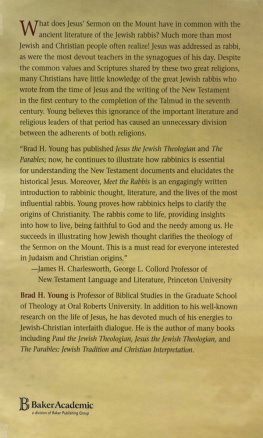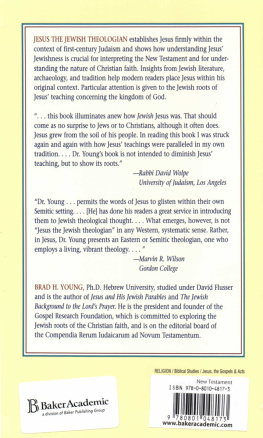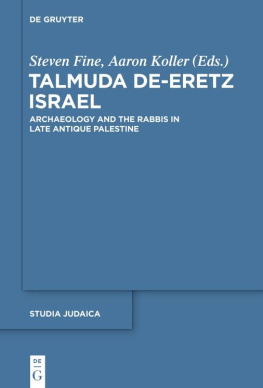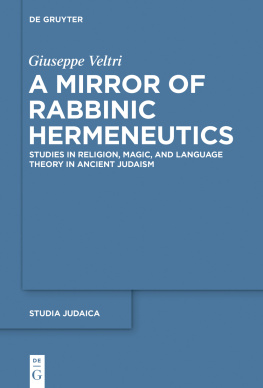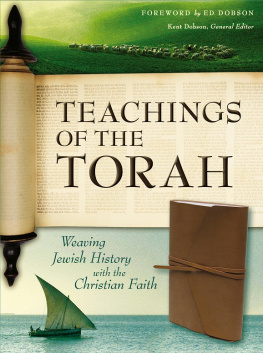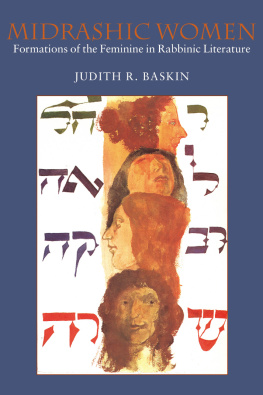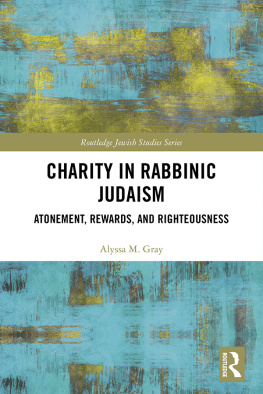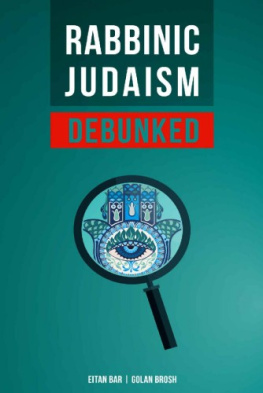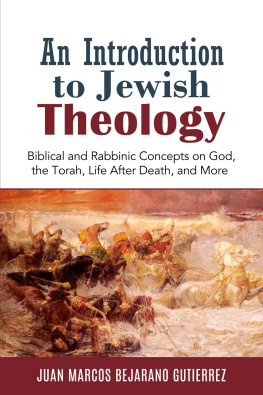Brad H. Young - Meet the Rabbis: Rabbinic Thought and the Teachings of Jesus
Here you can read online Brad H. Young - Meet the Rabbis: Rabbinic Thought and the Teachings of Jesus full text of the book (entire story) in english for free. Download pdf and epub, get meaning, cover and reviews about this ebook. year: 2007, publisher: Baker Publishing Group, genre: Religion. Description of the work, (preface) as well as reviews are available. Best literature library LitArk.com created for fans of good reading and offers a wide selection of genres:
Romance novel
Science fiction
Adventure
Detective
Science
History
Home and family
Prose
Art
Politics
Computer
Non-fiction
Religion
Business
Children
Humor
Choose a favorite category and find really read worthwhile books. Enjoy immersion in the world of imagination, feel the emotions of the characters or learn something new for yourself, make an fascinating discovery.
- Book:Meet the Rabbis: Rabbinic Thought and the Teachings of Jesus
- Author:
- Publisher:Baker Publishing Group
- Genre:
- Year:2007
- Rating:5 / 5
- Favourites:Add to favourites
- Your mark:
- 100
- 1
- 2
- 3
- 4
- 5
Meet the Rabbis: Rabbinic Thought and the Teachings of Jesus: summary, description and annotation
We offer to read an annotation, description, summary or preface (depends on what the author of the book "Meet the Rabbis: Rabbinic Thought and the Teachings of Jesus" wrote himself). If you haven't found the necessary information about the book — write in the comments, we will try to find it.
Meet the Rabbis: Rabbinic Thought and the Teachings of Jesus — read online for free the complete book (whole text) full work
Below is the text of the book, divided by pages. System saving the place of the last page read, allows you to conveniently read the book "Meet the Rabbis: Rabbinic Thought and the Teachings of Jesus" online for free, without having to search again every time where you left off. Put a bookmark, and you can go to the page where you finished reading at any time.
Font size:
Interval:
Bookmark:
[Image not included because of rights restrictions.]
The Torah Is a Tree of Life
My child, do not forget my teaching. Focus your heart to observe my commandments...


2007 by Brad H. Young
Published by Baker Academic
a division of Baker Publishing Group
P.O. Box 6287, Grand Rapids, MI 49516-6287
www.bakeracademic.com
Baker Academic edition published 2010
Previously published in 2007 by Hendrickson Publishers
Ebook edition created 2013
All rights reserved. No part of this publication may be reproduced, stored in a retrieval system, or transmitted in any form or by any meansfor example, electronic, photocopy, recordingwithout the prior written permission of the publisher. The only exception is brief quotations in printed reviews.
ISBN 978-1-4412-3287-8
Library of Congress Cataloging-in-Publication Data is on file at the Library of Congress, Washington, DC.
Scripture taken from the Holy Bible, New International Version. NIV. Copyright 1973, 1978, 1984 by Biblica, Inc. Used by permission of Zondervan. All rights reserved worldwide. www.zondervan.com (Italics in scripture quotations are authors emphasis.)
Scripture quotations are taken from the New American Standard Bible, copyright 1960, 1962, 1963, 1968, 1971, 1972, 1973, 1975, 1977, 1995 by The Lockman Foundation. Used by permission.
Cover art: Schiavone, Andrea (c. 15201563). Christ Teaching in the Temple. Location: S. Giacomo dellOrio, Venice, Italy. Photo credit: Cameraphoto Arte, Venice / Art Resource, N. Y. Used with permission.
Dedicated to the memory of Shony Alex Braun, masterful violinist,
composer, and humanitarian, who survived the Holocaust and gave joy
to millions through his magic fingers and charismatic personality.
(See Shony Alex Braun, My Heart Is a Violin
[Los Angeles: Shony Music, 2003])
Table of Contents
List of Illustrations and Maps
The illustrations on pages 33, 51, 94, 158, and 216 are from Bernard A. Solomon, The Zaddick Christ: A Suite of Wood Engravings . Greenwood, S.C.: Attic, 1973. Used with permission.
Foreword
Rabbi Charles P. Sherman
Four decades ago, I entered Hebrew Union Colleges Jewish Institute of Religion in Cincinnati to begin training as a reform Rabbi. During the course of my studies there, I was truly blessed to have required courses in the Inter-Testamental Literature and Period taught by Dr. Samuel Sandmel. Dr. Sandmel was a true pioneera Rabbi who was one of the worlds leading authorities on Christian Scripture. He provided his students with a methodology and a context for understanding texts with which we were, in general, unfamiliar. My rabbinate has certainly been enriched by what I began learning in Dr. Sandmels courses and also from his books.
I believe that Dr. Brad H. Youngs students in the Graduate School of Theology at Oral Roberts University are similarly blessed. They have the opportunity to study Jewish texts and thought, as well as to gain an understanding of the context for Christian Scripture, from a man who is both a scholar in Judaism and a faithful Christian. It has been my privilege to address Dr. Youngs classes on numerous occasions, and I have been impressed with his students curiosity about Judaism, as well as their openness and respect. I especially appreciate that Dr. Young believes Christians should not study rabbinic Judaism merely to understand more clearly the context of early Christianity, but also because Judaism is alive, well, and relevant today.
In this volume, Dr. Young introduces readers, who do not have to be scholars, to the Jewish context of Jesus life and times. The authors impressive knowledge of the period and of Jewish texts, and his ability to summarize vast amounts and types of literature clearly and interestingly, makes this volume very readable. Dr. Young moves readers from the more to the less familiar gracefully. It is my hope that this volume will whet the appetite of Christians new to this approach so that they will read other volumes by Dr. Young, as well as other scholars who appreciate the importance of both Judaism and Jews, historically and today. Jewish readers will also learn from this book.
As one who has toiled for many years in the interfaith vineyards, I have said repeatedly that my own faith has been strengthened, broadened, and enriched by what I have learned from other faith traditions. Dr. Young exemplifies that same belief in his efforts to help faithful Christians meet the Rabbis.
Rabbi Charles P. Sherman
Temple Israel
Tulsa, Oklahoma
Foreword
Dr. E. William Bean
In June, 2006 Dr. Brad Young took me to Bet Shearim during a study trip to Israel. Today this location is referred to as the tombs of the rabbis because of the rich archaeological remains of an enormous necropolis carved out of limestone with very impressive sarcophagi, many of which are resting in their original places. Moreover, in Jewish history Bet Shearim was known as an important center of Torah learning. Rabbi Judah Ha-Nasi, the compiler of the Mishnah lived, worked and was buried at Bet Shearim. This city had became the seat of the Sanhedrin. From this time on, the Bet Shearim burial grounds became an important site for Jewish history during the Mishnaic and Talmudic periods. The faith of the Jewish people flourished at Bet Shearim because of the spiritual and religious leaders who guided the community through hardship and adversity. But Dr. Young does not believe that the rabbis should be buried and forgotten.
It was at Bet Shearim during this trip to Israel that I learned about Dr. Youngs forthcoming book, Meet the Rabbis . I was honored when Dr. Young asked me to write a foreword to this great work.
Twenty-one years ago I was introduced to the Jewish background of Christianity as well as to the close connection between rabbinic literature and the New Testament. At that time, I had already served as a minister of a major denomination for over twenty-four years. After a complete study on the subject, I began to teach people about the Semitic background to the New Testament. For over twenty-one years I have devoted my life to the study of the beginnings of Christian faith and have desired to become Jesus centric, language centric, culture centric, and Kingdom centric in my research and teaching.
In this new book, Dr. Young emphasizes that Modern Christians selectively read the Gospels from the perspective of traditional church teachings. The perspective of the church changed rapidly after the destruction of Jerusalem in 70 C.E. The Body of the Lord drifted away from the Jewish roots that nourished the growing branch of the early church and began to become more influenced by Greco-Roman culture and to become Westernized in thinking and theology. When the Pharisees built a hedge around Torah, the church built a hedge around itself.
Dr. Young stresses that knowing rabbinic teachings and sources throws new light upon the teachings of Jesus, who lived in a world of the Eastern mind-set. He also mentions that to understand prayer, almsgiving, and fasting, the Christian should wholly concentrate on God. Learning about the world religion of Judaism does much to help us understand the start of Christianity.
According to Dr. Young we need master teachers, not master preachers. Dr. Young reminds us that when Jesus said, Go into the world and make disciples (Matt 28:19), the teaching of the Ethics of the Fathers (1:1) parallels this command with a similar statement,... raise up many disciples. He adds, For disciples to be made, there is first a need for master teachers. Dr. Young introduces his readers to Torah masters.
Next pageFont size:
Interval:
Bookmark:
Similar books «Meet the Rabbis: Rabbinic Thought and the Teachings of Jesus»
Look at similar books to Meet the Rabbis: Rabbinic Thought and the Teachings of Jesus. We have selected literature similar in name and meaning in the hope of providing readers with more options to find new, interesting, not yet read works.
Discussion, reviews of the book Meet the Rabbis: Rabbinic Thought and the Teachings of Jesus and just readers' own opinions. Leave your comments, write what you think about the work, its meaning or the main characters. Specify what exactly you liked and what you didn't like, and why you think so.

